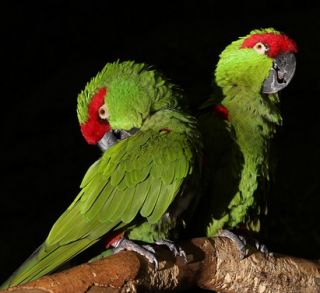Project Regions:
Thick-billed Parrot |
|
|
Collaborators/Funders
Organización Vida Silvestre A.C. (OVIS), Monterrey Tech (ITESM), San Diego Zoo Wildlife Alliance, Pro Natura International, Donner Canadian Foundation, Keith Ewart Charitable Trust
Thick-billed Parrots at risk from human pressures
With a population of about 2100 individuals, the Thick-billed Parrot (Rhynchopsitta pachyrhyncha) struggles against the loss and degradation of its habitat.
Project and progress: WPT has been supporting the Thick-billed Parrot Project based in Mexico. Its aims have been:
- Documentation of nesting areas
- Researching causes of chick mortality
- Provision of nest boxes
- Translocations
- Researching habitat requirements
- Disease screening and gene studies
- Education and awareness
Outcomes: Thick-billed Parrot preservation now relies on efforts to protect habitat and manage breeding. Work has also included disease screening and documenting chick mortality, diet requirements, and bird movements. The World Parrot Trust has funded studies to evaluate the long-term effects of translocation and habitat requirements for these parrots. WPT also funded the installation and general support of nest boxes to increase reproductive capacity, and critical genetics studies by Dr Tim Wright of New Mexico State University to determine how closely related the wild birds are, a possible detriment to their breeding and recovery. Long-term aid will focus on developing a habitat reserve, fostering local education initiatives, and encouraging sustainable resource use by local residents.
In 2005, ITESM, Pro Natura, and WPT co-hosted meetings to discuss solutions for the recovery of the species. The meeting included many parrot researchers and government and non-government organizations from both sides of the border. Subsequent sessions focused on further planning. In 2007 ITESM, Pro Natura and WPT conducted aerial surveys to evaluate suitable habitat and potential new release sites in N Chihuahua and Arizona.
In 2019 and 2020, WPT-supported Organización Vida Silvestre A.C. (OVIS) tracked birds in five breeding populations in the mountainous portion of Chihuahua were tracked. In 2022, the team is installing 30 new lightweight solar-powered transmitters provided by the San Diego Zoo Wildlife Alliance, which also collects and analyses the data. The institution has now conducted three years of Thick-billed Parrot tracking: 2019, 2020 and 2021, and is planning a 4th deployment for September 2022. They have collected 32,000 location fixes from transmitters attached to 30 parrots. These devices have helped to identify important water and mineral sources, and feeding, roosting, wintering and transit areas.
Please help us continue our efforts to save this species. |
|||
 |
|||
 |
|||
|
|||
World population: About 2100, stable
Where found: The highlands of Mexico in central and northern regions. Re-introduced to S Arizona, but some returned to Mexico.
History: The Thick-billed Parrot is confined to the Sierra Madre Occidental, Mexico, in NE Sonora, W Chihuahua, and south and west Durango and Michoacán. Smaller populations have been found in Sinaloa and Jalisco. Birds migrate to the states of Nayarit, Jalisco, Colima and Michoacán (Ortiz Maciel and Cruz Nieto 2004). It formerly was found in Arizona and New Mexico but was gone by the early 1990s (Ortiz Maciel and Cruz Nieto 2004). In Mexico, the population was estimated at less than 5000 birds by 1992 (Specimens in UMSNH per A. T. Peterson in litt. 1999), and 1,000-4,000 in 1995 (Lammertink et al. 1996). By 2004 the population was estimated to total 3000-6000 birds (Ortiz Maciel and Cruz Nieto 2004). Local residents have noted a general decline in flocks both in size and sightings. They have noted the loss of some local groups as well. (Ortiz Maciel, Cruz Nieto 2004).
Threats:
- Degradation and loss of pine habitat from drug growing and cattle grazing
- Loss of forest from fires and logging
- Loss of aspen nest trees
- Illegal trade in the species
Ecology: The Thick-billed Parrot is found in the highlands of Mexico in the central and northern regions. It was also formerly found in S Arizona. This species prefers mature upland primary growth pine forests in elevations from 1500-3000m (4920-9840 ft) where its primary food source, pine seed, seeds and buds of Pseudotsuga, fruits of Prunus capuli and acorns, occurs. Birds range widely after breeding and are found in flocks with communal roosting in inaccessible cliffs or densely packed trees. Foraging trips are up to 40 km in a day.


































